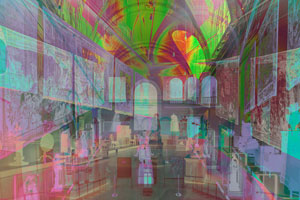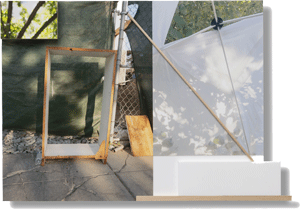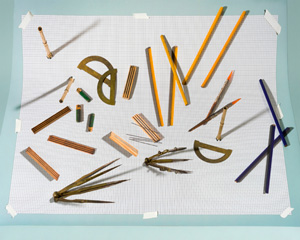Barriers to Photography
John Haberin New York City
James Welling, Sandi Haber Fifield, and John Houck
James Welling can make photography look like painting or, for that matter, pretty much anything else you like. He cherishes the marks of a photographic print all the same.
Life would be tough going, even if people did not put so many obstacles in their own way. One could try to clear them out by, say, spending less time alone with devices, viewing nonsense like mine. Sandi Haber Fifield delights in them, both the ones she observes and the ones she creates in photocollage. A barrier for her can stand in the way of knowing others, like the shadowy figures in her work.  Yet it is simply part of life—and the visual equivalent of memory. So is a perilous landscape for John Houck, as he turns from photography to painting.
Yet it is simply part of life—and the visual equivalent of memory. So is a perilous landscape for John Houck, as he turns from photography to painting.
Photos under UV light
Photos for James Welling come in all kinds, but they always make an impression. In close-up, orange lilies flare out in all directions, not least toward you. Streaks of yellow and purple might almost have come from a loaded brush, but alongside the precise outlines and vivid green of spores and leaves. They are in a great tradition of painted flowers, but they speak not of death within nature, but of life. Unlike painting within that tradition, from Flemish still life to Cecily Brown to this day, they do not serve as a warning, apart from a warning about painterly or photographic accuracy itself. If you leave thinking instead of silkscreen flowers from Andy Warhol, another artist with thoughts of death, you would not be far wrong.
Waves splash up against the picture plane, but they take their color from photocollage. They have the texture of bare canvas or of rocks along the shore. Like a classic seascape, more texturing brings out the blue of the ocean, both up close and up to the horizon. Its horizontals echo the familiar format of a landscape, and sure enough this is a painter's territory, the Maine coast that drew Winslow Homer to set up his studio and to look again to the sea. The gallery compares it to the gray sea for John Marin as well. It is Welling's usual UV-curable ink on aluminum nonetheless.
Wooden double doors have their own peeling paint, in a saturated blue that should surely have faded. They, too, insist on the picture plane and the human activity shaping nature. Welling's landscapes are a built environment, from Cubi, sculpture by David Smith on the Yale campus, to windows set back within concrete cubes for the brutalism of a government center in California. I mistook the layered horizontals of piers and background architecture for an ocean liner. The scenes range across the United States, but they keep returning to the artist's worktable, often as not outdoors. Stones and fabric in his studio have harsh lines and deep folds that all but insist on brushwork, but they dissolve into the dots of a screen print.
Welling's mind games are never less than visual, and they give equal attention to the photographic process and to real things. He calls the show his "Thought Objects." They invite one to rethink the artist's thoughts and the medium. He starts with photographs, but each print is a distinct object and a distinct step in the process as well. One can easily imagine plated loaded with ink pressed and dragged onto aluminum. One can see why he appears at MoMA in a show not of photography but of late modern prints, in collaboration with Jacob Samuel.
Welling has appeared in all sorts of contexts, as well as in frequent shows at the gallery. He has indulged in abstraction with black quadrilaterals and direct impressions on sensitive paper. He has been part of what Walter Benjamin called the Arcades Project, what the Met called "The Poetics of Place," and what a gallery called "The Photographic Object." He has appeared in ghostly color negatives and in washed-out blue in the 2008 Whitney Biennial. He comes closest to his experimental side here with prints that leave much of the paper untouched. All you get is traces of photography that only thus find their way into prints.
It is easy to take him for granted, and (as you can see from the sheer number of links), I often have. It is easy enough, too, to dismiss his large prints as pretentious, and they are not. Old standards of beauty, it turns out, get along just fine with the harsh scrutiny of UV light. You can start to ask something that you might have overlooked: in that moment between camera work and the print, is the photo an aim, a process, or a thing in itself? It takes all three to create a thought object.
Nature as built environment
Nature presents obstacles enough, from stony landscapes to dense undergrowth, and Sandi Haber Fifield brings them into sharp focus. The accumulated fragments in her collage create their own depth of field as well, layer upon layer. Her point of view shifts easily between face down and face front. One can feel oneself approaching things to push them aside. One can feel oneself, too, stepping back to find one's footing. Her considerable white space may or may not help.
 That is not to mention the built environment. Not that she necessarily distinguishes it from nature, no more than Welling or Houck. Potted plants with bare branches stand just outside a garage because her cuts place them there, but they could just as easily have grown there or landed there as home decor. A work crew must have piled those irregular gray stones. A man stands face to face with an entire wall of vegetation. Like the plants and stones, he may never find his way inside.
That is not to mention the built environment. Not that she necessarily distinguishes it from nature, no more than Welling or Houck. Potted plants with bare branches stand just outside a garage because her cuts place them there, but they could just as easily have grown there or landed there as home decor. A work crew must have piled those irregular gray stones. A man stands face to face with an entire wall of vegetation. Like the plants and stones, he may never find his way inside.
Much else, too, has no sense of home, only of barriers. That includes the one-piece plastic fencing that people love to hate—on top of her own thin strips of wood. A police cone has acquired colorful stripes and presides over torn branches in full leaf, like a memorial or celebration. If that suggests a death or absence, so do the silhouettes of boys at the beach. Do not, though, lose hope, for they are taking a break from exertion, and flowers, too, appear in silhouette. They are, the show's title has it, "The Thing in Front of You," and that is not the same as the thing in itself.
Mark Alice Durant, in the show's catalogue, compares her attention to that of a well-known painting by Caspar David Friedrich, the epitome of Northern Romanticism. A man stands on a rock, back to the viewer, looking out on distant mountains and foggy seas. Still, Haber Fifield (no relation to me) is not so much commanding as creating, and the layers keep coming, defying distance. Brutalist architecture comes at you corner on, one side in shadow. Her angled cuts echo the building's edge and her edge-on point of view. Once again, obstacles are just another word for experience.
Covid-19 brought its share of barriers to entry, but it gave her time, she says, to think. For the rest of us, what was there to do but take up knitting? And what was there to do after the lockdown but pick up the camera and get going? It may sound like a cliché, but Rachel Perry did both. She has not fallen for female stereotypes, but she makes the most of them. They become a window onto her studio.
Knitting for her is not folk art but Minimalism. And Minimalism, in turn, takes shape from the business of art in the present. Perry broke down cardboard boxes, delighting in the odd shapes that others would take to the trash. She also photographs herself with her work, in a floor-length dress of many colors, in diagonal stripes. She also keeps finding ways to hide her face, with her back to the camera or a mirror between her and you. Barriers take many forms, and they belong to artists that you may never see.
Erupting into painting
John Houck has taken up painting. He has been turning more and more to oil on linen, a seeming contrast with the clarity of his photography. Yet he has brought elements of painting to his work longer still. One series incorporates fine variations that make a single color layered, textured, and bright. He also folds the paper across more or less the middle, both vertically and horizontally, and the pleats suggest fields of color even in monochrome. Other prints have elements of still life, including drafting tools, but also touches of paint. 
Painting has long haunted the medium. Photography had to prove itself an art for those who worry about such things, like the Victorian staged portraits of its early years, and the AIPAD art fair still bends over backward to assure collectors that it is arty enough. When it comes down to it, the "decisive moment" for Henri Cartier-Bresson, of a figure poised in midair or the perfect Paris street, is also an artful one. Houck's still life, in turn, recalls Synthetic Cubism in its layers of paper defining the picture plane, while the Met has struggled to claim Cubism for the "trompe l'oeil tradition" in Baroque painting. Never mind that Georges Braque and Pablo Picasso were conspiring to throw paint and tradition to the winds. Only now, though, does Houck devote a show to painting and nothing else.
If paintings still come as a surprise, it is because he retains his old medium's clarity without the precision. He has given up the self-referential signs of studio practice for landscape, and what strange landscapes these are. To be sure, while he appeared in "Public, Private, Secret" at the International Center of Photography back in 2017, he keeps nothing secret. These are perilous landscapes indeed, with sharp drop-offs from the curved edge of foreground cliffs. Volcanos tower above, both dormant and wildly erupting, filling the air with near vertical clouds of ash. Just as obvious is the thick white cloud taking over a painting.
Still, the clearer he becomes, the less he promises to make sense. In no way could these elements share a landscape, and he relishes it. Leaps into depth defy human perspective as well. Railroad tracks taper and curve unnaturally as they extend into depth. Colors are no more reasonable, from the purple cliffs to a flat, red sky. It could be no more than a curtained backdrop, and other elements cast their shadows on earth and sky.
Those objects descending from chains are, it turns out, family heirlooms. (Maybe Houck has his family secrets after all.) They are bells, although their edges, like the top edge of a royal crown, surely cut too close for them to ring out all that loudly. The entire landscape seems strangely quiet in the midst of eruptions, and the tracks do not hold an onrushing train. He adopts relatively mute colors as well and, as in his photos, a disdain for high drama. The show is, after all, "Perfect Temperature Lava."
If Welling in Tribeca makes photography look like brushwork, give or take the pixels, Houck likes painting for its refusal to stay put in the physical present. (At the gallery's other space across the street, Yi Xin Tong insists on his media's presence with acrylic, clay, cuts, and glue.) He builds landscapes the old-fashioned way, from shaded drawing or underpainting, but they owe more to the imagination than to observation. Paradoxically, the bells are real and observed. The lack of drama can leave me wondering, and I may recoil at a landscape's mysteries. Yet he is still puzzling out the remembered and the seen.

James Welling ran at David Zwirner through February 10, 2024, Sandi Haber Fifield and Rachel Perry at Yancey Richardson through February 17, and John Houck and Yi Xin Tong at Candice Madey through March 2. A related review looks at John Houck in photography.




